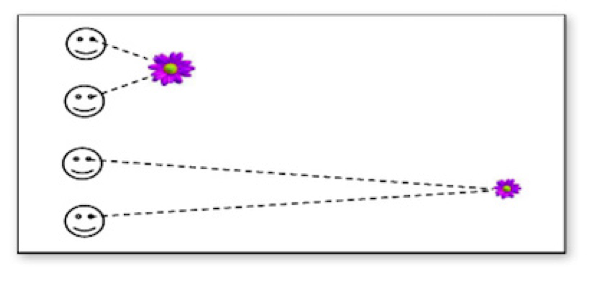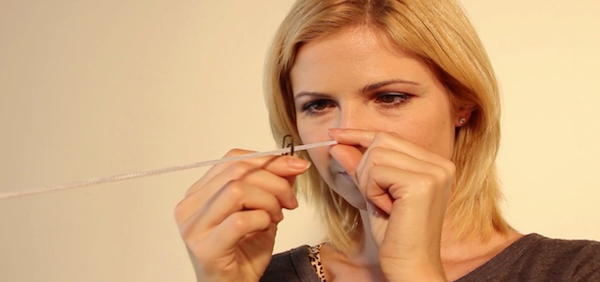
20 Nov That’s why eye coordination is so important
How does our eye coordination actually work?
Our eye coordination is responsible for ensuring that we can see objects clearly, whether they are moving, near or far away. Our eyes rotate slightly, depending on the distance from the object, so that the central fovea, the point of sharpest vision, is directed directly at the object under observation. For example, if you pull a thread into a needle’s eye very close in front of your eyes, your eyes will rotate slightly inward. When you look at a distant landscape, your eyes are straight. This “focusing” through the eyes is called convergence. If eye coordination works well, we have depth perception. The brain automatically merges the images of the left and right eye into three-dimensional perception. That’s why you can immediately see whether something is spatially far away or very close in front of us.
Why is good convergence so important?
 If convergence doesn’t work well, we’ll be misjudging distances. Many people who suffer from presbyopia also have convergence problems. If this coordination problem is weak, reading ability is not impaired. Even people with monovision, who usually use only one eye, develop alternative strategies to assess distances by, for example, orienting themselves to the size of objects. However, this means more work and stress for the visual system.
If convergence doesn’t work well, we’ll be misjudging distances. Many people who suffer from presbyopia also have convergence problems. If this coordination problem is weak, reading ability is not impaired. Even people with monovision, who usually use only one eye, develop alternative strategies to assess distances by, for example, orienting themselves to the size of objects. However, this means more work and stress for the visual system.
The development of eye coordination
It is assumed that the ability to see stereoscopically is developed at about four months of age and fully developed at about eight years of age. It is assumed that the visual system is fully developed in eight-year-olds.
Identifying problems with eye coordination
So how do you know if you have eye coordination problems?
Problems with spatial vision are one of the signs of eye coordination problems. Blurred vision and double vision can also indicate eye coordination problems. If reading a text after a short time makes you tired, your eyes start to hurt, or the text moves after a while, this may indicate that your convergence point is shifted, i.e. that your eyes are not sharply focused on the object you are looking at.
Especially with presbyopia, there is often a problem with eye coordination. But even short-sighted people whose eyes have very different visual acuity often cannot coordinate their eyes properly. But this is almost never tested. Most tests are carried out when there are severe convergence problems that are also visible to others, because the position of the eyes is affected. This condition is called strabismus, the cause of which is still unknown.
Problems with eye coordination can occur with all other visual impairments. They are often also part of the vision problem.
Eye test for eye coordination
Have you ever had your eye coordination checked?
Probably not, although it is so quick and easy.
There is a simple test where you can quickly find out if your eye coordination is working properly or if it is problematic. For the eye coordination test you will need a cord and paperclip. Tie one end of the cord to a chair back or firm handle and pull the paperclip onto the cord. Now hold the second end of the string against the tip of your nose so that the string is taut. Now pull the paperclip close to your eyes and look at it with both eyes.

With good eye coordination, you will notice a crossing point at the paper clip location and see the string behind and in front of it as an X. Repeat this test at different distances up to arm’s length. Depending on how you look at the string while looking at the clamp, you will see how your eyes converge. You can find a more detailed description with a short demonstration video and further eye coordination tests in our members area. There you will also find vision tests and exercises for all other visual impairments, which you can perform at home with simple means.
Eye training is statistically proven in case of problems with eye coordination.
The good news is that with eye training we can significantly reduce eye coordination problems within a few weeks.
A study by the American Optometric Association tested the visual training patients before and after eye training. Previously, only 6% of patients were able to pass the eye test. After eye training it was 96%. Our exercises are well proven and have been successful for decades. We would like to briefly introduce one of them to you:
The long swing exercise (also called the elephant swing)
 You’re looking at something you’d like to see sharper. Place your feet parallel on the ground with a hip-wide distance and close your eyes. Then shift your weight from one foot to the other slowly and evenly. Your head and shoulders should be in the slight swinging motion. The arms hang loosely down and move automatically with the swinging movement. After a while, open your eyes and look at the object you have chosen again. You should now be able to perceive it more clearly. In our member area the exercise is very well illustrated with a video.
You’re looking at something you’d like to see sharper. Place your feet parallel on the ground with a hip-wide distance and close your eyes. Then shift your weight from one foot to the other slowly and evenly. Your head and shoulders should be in the slight swinging motion. The arms hang loosely down and move automatically with the swinging movement. After a while, open your eyes and look at the object you have chosen again. You should now be able to perceive it more clearly. In our member area the exercise is very well illustrated with a video.
You can find more about eye tests here: Vision test


